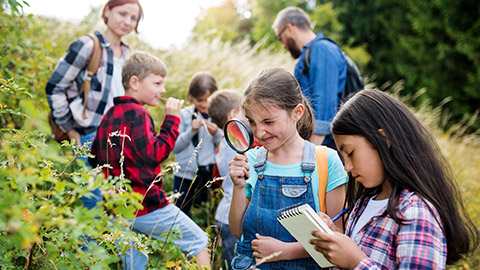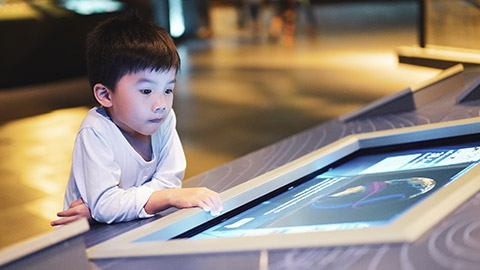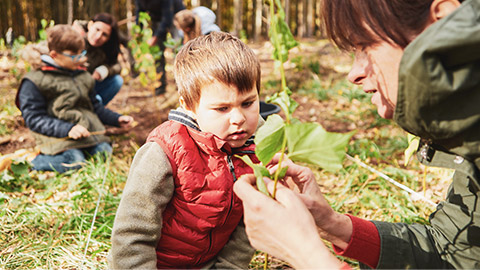Understanding and engaging with the local and broader community is fundamental to Early Childhood Education. Children’s experiences within their communities shape their sense of identity, belonging, and social responsibility. By fostering connections with their surroundings, educators help children develop a deeper understanding of the world and their place within it.
This process involves exploring the physical spaces around them, interacting with community members, and learning about cultural and social diversity. Such engagement not only enhances children's cognitive development but also builds their empathy, cooperation, and appreciation for the diverse world they live in.

Children's education and care services play a crucial role in fostering a sense of belonging and connection between children and the broader community. By helping children learn about and engage with the community, these services support children's social, emotional, and cognitive development and prepare them to be active and responsible members of society.
Services can support children's learning about the community: As it is and as it was.
The Early Years Learning Framework (EYLF): Being, Becoming, and Belonging
The Early Years Learning Framework (EYLF) is a national guide that outlines the principles, practices, and outcomes essential for early childhood education in Australia. The EYLF is built around three key concepts:
| Principles | Practices | Learning Outcomes |
|---|---|---|
|
|
|
Belonging, being, becoming
Belonging highlights the importance of relationships and connections in a child’s life. It acknowledges that children’s sense of belonging is central to their identity and well-being. When children feel they belong to a family, cultural group, community, or early learning service, they are more likely to feel confident and secure, which enhances their learning and development.
Being refers to the importance of allowing children to experience childhood in the present. It emphasises the value of children engaging in meaningful activities, forming relationships, and exploring the world around them. It recognises the importance of children enjoying their childhood and learning through play, discovery, and interaction.
Becoming reflects the process of rapid and significant change that occurs in the early years as children learn and grow. It focuses on the development of children’s identities, knowledge, skills, and understanding. This concept emphasises the role of early childhood education in shaping children’s futures and helping them develop into capable, confident individuals.
Outcome 2: Children Are Connected with and Contribute to Their World
Outcome 2 of the EYLF emphasises that children should develop a sense of connection with their community, environment, and the broader world. It encourages children to understand their role within their community, to respect diversity, and to become aware of their responsibility toward others and the environment.
This outcome is focused on helping children:
- Develop a sense of belonging to groups and communities
- Respond to diversity with respect
- Become socially responsible and show respect for the environment.
Incorporating Outcome 2 into the Service
Educators can support Outcome 2 by implementing a variety of strategies and activities within the early learning environment:
| Fostering a Sense of Community | Group Activities: Encourage group play and collaborative activities that require children to work together, share, and communicate. This helps them understand the importance of cooperation and builds a sense of community. Cultural Celebrations: Celebrate cultural events and holidays that reflect the diverse backgrounds of the children. This promotes respect for diversity and helps children learn about different traditions and practices. |
| Encouraging Environmental Awareness | Sustainable Practices: Introduce sustainable practices within the service, such as recycling, composting, and conserving water. Educators can involve children in these activities and explain the importance of caring for the environment. Nature Exploration: Provide opportunities for children to explore nature, such as outdoor play, gardening, or nature walks. These activities help children connect with the natural world and understand their role in protecting it. |
| Promoting Social Responsibility | Community Involvement: Engage children in community-based projects, such as participating in local clean-up days, visiting community centres, or contributing to charity drives. This helps children understand the importance of contributing to their community. Inclusive Practices: Create an inclusive environment where all children feel valued and respected. This can include adapting activities to meet diverse needs, using resources that reflect different cultures, and teaching children about fairness and inclusion. |
| Respecting and Responding to Diversity | Cultural Learning: Incorporate books, stories, and activities that reflect various cultures and languages. Educators can invite families to share their cultural practices or involve children in multicultural activities. Dialogue About Diversity: Encourage open discussions about differences, whether they are cultural, linguistic, or related to abilities. This helps children develop empathy and understanding for others. |
| Incorporating Community in the Curriculum | Real-World Learning: Integrating community-focused projects into the curriculum allows children to apply what they are learning in a real-world context. For example, a project on sustainability might involve visiting a local recycling centre or planting a community garden. Reflecting Community Values: The curriculum should reflect the values and priorities of the local community, ensuring that children’s education is relevant and meaningful. This might include learning about local environmental issues, celebrating regional arts and crafts, or engaging with community health and wellness programs. |
| Engagement with Local Resources | Visits and Excursions: Organising visits to local libraries, parks, museums, and other community facilities allows children to experience their community firsthand. Such excursions help children understand the resources available to them and how these places contribute to their community's well-being. Guest Speakers: Inviting local community members, such as firefighters, police officers, artists, or healthcare professionals, to speak to the children can provide valuable insights into different roles within the community. These interactions help children see how various professions and services function and contribute to society. |
| Building Social Connections |
Community Projects: Involvement in community-based projects, such as gardening initiatives, local clean-up days, or charity drives, gives children a sense of responsibility and teaches them the importance of contributing to their community. |
By integrating these practices into the daily routine, educators can effectively support children in achieving Outcome 2 of the EYLF, helping them to become connected, respectful, and responsible members of their communities and the broader world.
For more information on how you can support children in connecting with their local community, click here
Case Study

Archer is a four-year-old who attends a service near the city but lives about 40 kilometres south, outside the local community. In the Preschool room, the children go on community walks each week and track their routes on a map. During these walks, they discuss what they see, including old buildings, and the children point out where they live.
Archer has shown a keen interest in the mapping activity and mentioned to his educator that his house isn't on the map because it's too far away.
In response, the educator spoke with Archer's family and decided to print a larger map that tracks the drive Archer takes each morning. Archer then shares this with the class.
They also took photos of the streets near his home to show to the class. With his parents' help, Archer identified the landmarks around his neighbourhood.
This ongoing discussion about community led to exploring topics like culture, who lives in the community, and what defines a community.
The educator recognises that without the involvement of Archer’s parents, his learning experience wouldn’t have been as enriched.
They planned an excursion to the beach near Archer's house and included a drive past his home on the way back.
Watch
Practice - support children's connection with their community
List three services you could connect your children and families to within your community. Describe how you would implement this connection.
- Outline the information you could display about this community group in your service.
- Explain the benefits this connection would have to children, families, and the community.
Ensure that you keep notes for future reference, as this information will support your assessment and professional practice.
For children, their connection with their local community is important. They can maintain a sense of belonging by engaging in community events and traditions. Additionally, participating in local community activities helps foster children's development of positive relationships with family and friends.
Alone, we can do so little; together we can do so much.Helen Keller
Connecting to their local environment
Children need to develop a connection with their local community. There are many ways to engage in community events and traditions. Families can participate in local community activities together. Friends can also introduce children to new activities and experiences in the community. Children can learn about different aspects of the community through these experiences. They can also develop a sense of belonging and pride in their community.
Community involvement builds children's interest in the world around them. Local community activities engage and teach children about different aspects of their community and help them learn how to be active and involved citizens.

Reading
Read the ACECQA We Hear You Blog - It takes a village to raise a child: The role of community.
Connecting children to their community
Here are some effective ways to access and engage children with their local community:
By incorporating these strategies, educators can create meaningful opportunities for children to connect with their local community, enriching their learning experiences and fostering a stronger sense of identity and belonging
Practice - community engagement
Thinking about the philosophy, policies and practices of service (you can use Little.ly Early Education), explore how they support positive relationships between:
- The service, families and local schools?
- The service, families and community/support organisations?
What opportunities do children have to engage in their community beyond the service?
Ensure that you keep notes for future reference, as this information will support your assessment and professional practice.
Watch
Watch the following YouTube video from the Department of Education and Training, Victoria, to learn more about how community and learning go together: Community Engagement in Learning.

Engaging families in their children's exploration of the local community is important. Children can gain valuable insights into their community by involving parents in this process. Families can be invited to provide insights into their communities and networks and share these with the service.
Displaying information at the service
Inviting family and friends to explore the local community with children can help them learn more about their community and its resources. This informs families and encourages bonds, and builds understanding of their community. They can also be an important source of support for providers, especially when navigating local networks.
Childcare providers can play a crucial role in helping families connect with their local community by offering information and support about available resources. Providing families with accessible materials and services can ensure that families are well-informed about the community services they can access. Here are some ways to effectively display this information:
| Dedicated community resource board | Location: Place the board in a high-traffic area, such as the entrance, reception area, or parent lounge, where families are most likely to see it. Content: Include brochures, flyers, and factsheets about local healthcare providers, educational resources, community events, and family support services. Organise the information into clear categories, such as "Healthcare," "Education," "Recreation," and "Support Services." Interactive Elements: Add a local area map with key community locations marked. You could also include QR codes that parents can scan with their phones to access additional online resources or websites. |
| Digital Displays | Screens in Reception Area: If your service has a digital screen, use it to showcase community information. Create a rotating slideshow that highlights upcoming community events, local services, and available resources. Parent Portal or App: Many early learning services use digital platforms or apps to communicate with parents. Ensure that these platforms include a section for community resources where parents can easily access up-to-date information. |
| Monthly newsletters |
Printed or Digital: Include a section in your monthly newsletter dedicated to community resources and upcoming events. This ensures that parents receive regular updates and can plan to participate in community activities. |
| Family Resource Corner | Setup: Create a comfortable corner in your service where parents can sit down and browse through resource materials. Include a bookshelf with brochures, booklets, and local service directories. Interactive Notebook: Place a notebook where parents can write down questions or request specific information about community services. Educators can then respond by adding new resources to the board or corner. |
| Workshops and Information Sessions | Inviting Local Experts: Host regular workshops or information sessions at your service where community experts, such as health professionals or family counsellors, can share valuable information directly with parents. Parent Engagement Events: Organise events where families can learn about local resources and services in a more interactive setting, such as a "Community Night" where different service providers set up booths to talk to parents. |
| Cultural and Community Events Display | Seasonal Displays: Create thematic displays for upcoming cultural and community events, such as festivals, markets, or public holidays. Decorate the area with relevant cultural items, and provide information on how families can participate. Interactive Calendar: Maintain a large, visually appealing calendar that marks important community events. Encourage families to add their events or suggestions for activities they’d like to see the service involved in. |
Accessing information for different family needs
The information included in these materials could cover the following:
Healthcare Services
- Local Clinics and Hospitals: Information on nearby healthcare facilities, including general practitioners, pediatricians, dental clinics, and hospitals.
- Specialist Services: Contacts for child development specialists, such as speech therapists, occupational therapists, or mental health professionals.
Educational and Child Development Resources
- Early Intervention Programs: Details about programs available for children with developmental delays or special needs.
- Libraries and Educational Centres: Information about local libraries, learning centres, and available educational programs or workshops for children and parents.
Family Support Services
- Parenting Support Groups: Information on local parent groups, support networks, and workshops providing parenting guidance and resources.
- Counselling Services: Contact details for family counsellors or community organisations that offer support for family and relationship issues.
Recreational and Cultural Activities
- Parks and Playgrounds: Locations of nearby parks, playgrounds, and outdoor recreational facilities where families can engage in physical activities with their children.
- Community Events and Cultural Programs: A calendar of local events, festivals, and cultural programs that families can participate in to immerse themselves in the community’s culture and traditions.
Childcare and Educational Services
- Daycare and Preschool Options: Information on other local childcare providers, preschools, and after-school programs.
- Tutoring and Extracurricular Activities: Listings of available tutoring services, language classes, music lessons, and sports clubs that children can join.
Financial and Legal Assistance
- Community Legal Aid: Resources for families needing legal advice or assistance with issues such as immigration, housing, or family law.
- Financial Support Services: Information about local organisations that provide financial assistance, budgeting advice, or access to food banks and other essentials.
Transportation Services
- Public Transport Information: Details about local bus routes, train services, and transportation options that are accessible to families.
- Carpool Networks: Information on community carpool services or ride-sharing options that can help families without access to personal vehicles.
By providing these resources, childcare providers can help families feel more connected and supported within their local community, ensuring they have access to the services they need for their child's well-being and development.
Case Study: Connecting Families with Community Resources
Scenario: The Bright Futures Early Learning Center is located in a suburban area with a diverse population, including many families who have recently moved to the community. One of the children, Mia, a three-year-old, has just started attending the centre. Mia’s parents, Sarah and David, are new to the area and are feeling somewhat isolated, as they are unfamiliar with the local community and its resources.
Issue: Sarah and David are concerned about finding appropriate healthcare and educational support for Mia, especially since they don’t know anyone in the area. They also want Mia to engage in activities that will help her adjust and thrive in her new environment. However, they are unsure where to start and are overwhelmed by the process of finding reliable services.
Action Taken by the Childcare Provider: The educators at Bright Futures recognise the importance of connecting Mia’s family with the local community to help them settle in and access the support they need. The centre’s director, Emily, decides to create a tailored information pack for Mia’s family.
Educational Resources: Understanding the family’s interest in supporting Mia’s learning, Emily includes information about the local library’s storytime sessions and early literacy programs. She also adds contacts for nearby playgroups and early intervention services in case Mia needs additional support.
Recreational and Social Activities: To help Mia socialise and engage with other children, Emily lists nearby parks, playgrounds, and community centres that offer toddler playgroups and family activities. She also includes details about upcoming community events, such as a local festival and a farmers’ market, where the family can explore their new neighbourhood.
Family Support Services: Aware that moving to a new area can be challenging, Emily includes resources for family support services, such as local parenting groups and counselling services. She also provides information about a nearby family resource center that offers workshops on parenting, stress management, and family health.
Outcome: After receiving the information pack, Sarah and David feel much more confident and supported. They attend a few community events and connect with other families in the area. Mia starts participating in the library’s storytime sessions, which helps her improve her language skills and make new friends.
Over time, Mia becomes more settled and happy at Bright Futures, and her parents feel more integrated into their new community. Proactive support from them played a crucial role in helping the family adjust and thrive in their new environment.
This case study highlights the importance of childcare providers in facilitating connections between families and their local community. By providing tailored information and support, childcare services can help families access essential resources, engage with their community, and ensure their children’s well-being and development.
Practice - parents involved in community learning
Explain why it is important for families to be involved in community learning by the children. Consider your local community and reflect on the following questions.
- List three services you could connect your children and families to within your community. Describe how you would implement this connection.
- Outline the information you could display about community groups in your service.
- Explain how this connection benefits children, families, and the community.
Ensure that you keep notes for future reference, as this information will support your assessment and professional practice.
